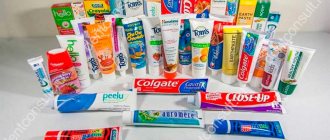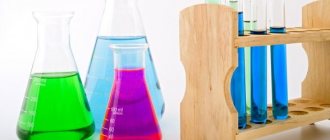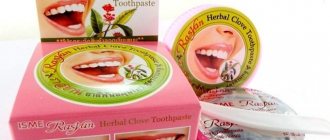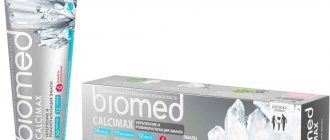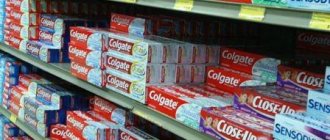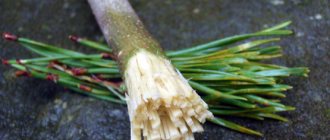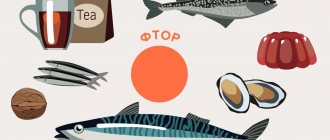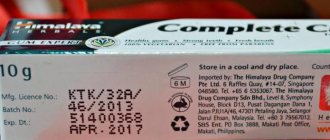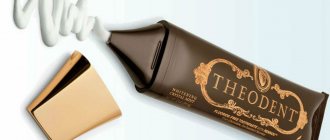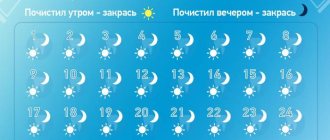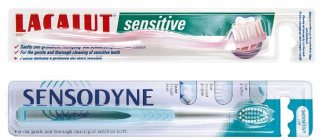“Secret” composition of toothpastes
The composition of the most ancient toothpastes, the recipes for which were found during excavations, included rather dubious substances: ashes of cow entrails, crushed egg shells, crushed pumice and... urea (yes, ammonia probably whitens teeth well).
The harm of the toothpaste used by the Egyptians (it was in Ancient Egypt that the recipe for toothpaste was found) can hardly be proven or disproved.
But the fact is that most of the popular toothpastes that we use today contain chemicals that are completely unsafe for our health
, we will tell our readers in detail today.
To answer the question of which toothpaste is the safest, you need to study its composition. Most toothpastes contain the following basic chemical elements: fluoride, triclosan, sodium lauryl sulfate
– they will be discussed in the article.
Foaming substance: aka sodium lauryl sulfate, aka SLS, aka surfactant
The most dangerous substance, which is part of 90% of toothpastes, is not fluoride, which has been talked about lately, but a foaming substance - sodium lauryl sulfate.
Most often it is denoted by three Latin letters SLS or Cyrillic - PAV.
It is this substance that, when it enters the oral cavity, foams and destroys plaque from tooth enamel.
This product is obtained by chemical synthesis of coconut oil.
. It is added to car detergents.
Dentists do not hide the fact that toothpastes containing sodium lauryl sulfate are dangerous to health.
The harm of toothpaste with SLS is also confirmed by ophthalmological studies: after using a toothpaste containing sodium lauryl sulfate, vision deteriorates by 5%.
Therefore, when choosing a toothpaste, pay attention to how it foams.
It turns out that the less foam, the better the quality of the toothpaste. The inscription SLS free
means that the paste contains
NO
foaming substance.
Forewarned is forearmed!
Let's summarize: the harm to human health from using toothpaste with fluoride today cannot be considered a scientifically proven fact. Research in this direction is carried out regularly around the world, and its results can be found from open sources. It’s up to you to decide which product to choose for daily oral care for yourself and your loved ones. But when making such a serious choice, remember two important nuances.
- Fluoride is poison, and fluoride is medicine.
- Excess fluoride leads to fluorosis, while its deficiency makes the way for caries easier.
The dangers of fluoride in toothpaste
You've probably already heard about the dangers of fluoride in toothpaste? Is it true?
Let's start with the fact that the body's daily need for fluoride is 2 - 3 mg.
When American scientists discovered in the 40s that fluoride can heal holes in teeth - literally “patch them up” - it began to be added to all toothpastes. Soon the joy over this discovery subsided. They began to treat fluoride in toothpaste with caution and caution.
Still would! It turns out that this chemical element (“fluoride” is translated as “destructive”) is a toxic substance and its excess leads to tooth decay.
With an excess of this toxic element in the body, phosphorus-calcium metabolism is disrupted. This has been proven by many studies. excess fluoride gets directly onto the tooth,
. First, white spots appear, then they turn yellow and then the tooth enamel is destroyed.
Today, serious research is being conducted, the results of which confirm not the benefits, but the harm of fluoride in toothpaste.
Excess fluoride in the body not only causes dental problems, but also leads to brain diseases. It should also be taken into account that fluoride accumulates not only in teeth, but also in bones
. It can change the structure of bone tissue, even causing bone cancer.
Fluorine in the human body
Why is fluoride added to toothpastes? All this turns out to be commercially profitable. This is described in detail in K. Bryson’s book “Fluorine – the Big Deception”, where the myth about the benefits of this chemical element for humans is revealed.
We can get the daily amount of fluoride needed for our teeth by eating, for example, only 3 apples.
But the most important source of fluoride is water
! When buying toothpaste, do you consider what kind of water comes out of your tap? Hardly. But in vain!
The fact is that in many regions of Russia, water already has a high fluorine content (for example, in the Leningrad and Nizhny Novgorod regions, in Mordovia, Western Siberia, and some areas of the Moscow region). Residents of these regions only need to drink 1 liter of water to get half the daily fluoride requirement.
In Russia and Ukraine, there is a water fluoridation program, according to which fluoride is added to the water before it enters the water supply. In addition to water and apples, fluoride is found in fish and tea. That is, a person receives the daily amount of fluoride necessary for teeth from water and food
. Why add it to toothpaste?
The list of diseases that are caused by excess fluoride in the body could take half the article, so we will not list them.
The main conclusion: the safe amount of fluoride needed by our teeth enters the body through water and food. Therefore, it is better to choose toothpaste without fluoride.
Especially for residents of those areas where the water already contains fluoride compounds.
A safe fluoride-free toothpaste must contain calcium, which binds excess fluoride ions and remineralizes teeth.
Sympaty.net advises residents of those regions where the water contains high amounts of fluoride to use water filters
, which will cleanse it of excess of this chemical element.
CONCLUSIONS.
Only you can decide which option suits you best. I would advise you to first buy a toothpaste with a good composition, so that giving up harmful toothpastes will go completely unnoticed. And only then experiment, try other options... If you wish!
By the way, toothpastes appeared in people’s everyday life relatively recently, a little over 100 years ago. Dentist Washington Sheffield came up with a tube in 1892))) The idea with tubes took off, and since then the paste has completely replaced all other means of cleaning teeth. Before toothpaste, people used tooth powders. I saw them actively used in childhood. And before purchased powders, people in the old days made such powders themselves - from ash, salt, roots... Hindus made and continue to make powders from herbs and even their dried ground banana skins))))
Good luck finding your best teeth cleaner! Write to me if you have anything to share on this topic!
If you don’t want to miss new releases of articles, then subscribe to the newsletter! If you liked the article, share it with your friends using social networks:
Tags:home without chemicals, it's interesting!
Antibiotics...in toothpaste?
The antibiotic
triclosan
, which is part of the most popular toothpastes , can be no less dangerous than fluoride This antibiotic is added to kill harmful germs and bacteria in the mouth.
However, triclosan destroys not only pathogenic organisms, but also beneficial bacteria and microbes in the mouth.
In this case, harmful bacteria appear again, and useful bacteria, those that fight harmful microorganisms, may disappear altogether.
The safest toothpaste: how to determine?
In the United States, warning labels are placed on tubes stating that if you swallow toothpaste, you should immediately consult a doctor for help in case of poisoning. Not only will you not find a warning label on the tubes of our toothpastes, but the composition is often not even indicated. It is usually listed on the packaging, which is thrown away.
But still, a tube of toothpaste can tell us something. Have you ever noticed that toothpaste tubes have horizontal stripes of red, black, green and blue? Do you think it's just design? You are wrong. So information about the composition.
- Thus, a black
horizontal stripe indicates that the paste contains substances that increase periodontal disease. Such toothpastes should not be purchased by people with gum disease. - But the red
stripe indicates that the paste contains substances hazardous to health, such as fluorine, lauryl, triclosan, polyethylene glycol (PEG), oxybenzene, etc. - A safe toothpaste containing synthetic substances will have a blue
stripe on the tube. - The safest toothpaste has a green
label. A green stripe indicates that the paste consists only of natural raw materials.
HOW TO BRUSH YOUR TEETH WITHOUT HARM?
It may seem that there is no way out, because only such pastes are sold in stores... There are many different brands, but the composition is always chemical. But I have good news - natural cleaning products exist, and in a fairly wide variety ))) They are simply sold in other stores, because they cannot compete with mass brands for space on the shelves of large supermarkets... Manufacturers of natural pastes do not produce products on such a gigantic scale and they do not have a multi-billion dollar budget to promote the product. But they have a wonderful composition of natural ingredients and the gratitude of those who use them))) And this is not little!
For a detailed report on what teeth cleaning products I use, read the article: REVIEW “NATURAL TOOTH PASTES AND POWDERS.” From the article you will find out which dental products I liked the most and why. And also how much they cost and where they can be purchased.
In the meantime, I will briefly describe how, in principle, you can brush your teeth safely, without fear for your health. There are 3 main options:
Option number 1 - powder from the store
Buy tooth powder containing only natural beneficial ingredients. What do I mean by natural ingredients? Everything here is extremely simple - you read the ingredients and if all the ingredients are familiar to you from childhood, then this is a natural powder. If strange names appear that resemble chemical compounds from chemistry lessons, then this is not what we need... There are several manufacturers of such powders - Russian and foreign. They are sold in popular health food and cosmetics stores. Also always available in Hindu Ayurvedic shops.
Option No. 2 - handmade powder
Make your own powder at home. It's not difficult at all. You can find recipes on the Internet or look at the composition of powders from stores (see point 1) and reproduce something similar at home. The cooking process is extremely simple. There is no need to boil anything in a water bath, soak it, etc. You just buy everything you need and mix it in a convenient jar.
Option No. 3 - almost natural paste
This is the most common option to use. Because the powder does not foam and is not always convenient to take with you on the road. And the pasta is free of these two disadvantages. But the paste is not so ideal in composition. No, of course it does not contain any of the dangerous, toxic substances that I wrote about in detail in this article. But there cannot be 100% natural ingredients here, otherwise the consistency will not be so smooth and uniform, the color will not be so pleasant, etc.
But the unknown compounds in such pastes are usually made from natural ingredients and do not cause serious harm to health. For example, sodium silicate may be found. This is a food additive E-550, which is produced from natural materials, for example, from silicon-containing raw materials. This is a substitute for harmful aluminum silicate. Or xylitol - a plant sweetener that is naturally found in fibrous vegetables and fruits, corn cobs and birch bark. For a detailed list of ingredients in natural toothpastes that have scary names but are actually harmless, see the article: “Review: Natural Toothpastes and Powders.”
Such pastes may also contain less natural substances. These are usually 1-2 controversial components, which some consider harmful, while others consider safe. For example, sodium CMC (sodium carboxymethylcellulose) is an E-466 food additive made from soda and cellulose. Or sodium saccharine (sodium saccharine) - food additive E-954. Sweetener of synthetic origin. For a detailed and clearly presented list of such controversial components of toothpastes, see the article: “Review: natural toothpastes and powders.”
By the way, the “correct” pastes are sold in the same health stores and Hindu shops. They can also be found in homeopathic pharmacies.
